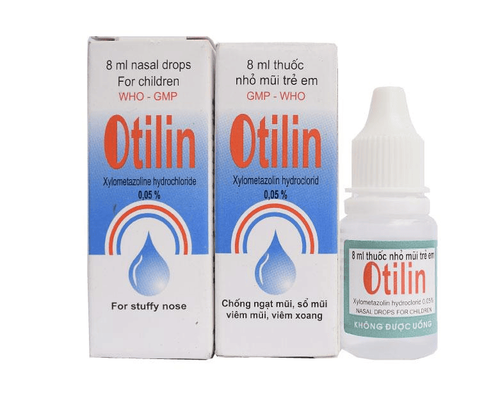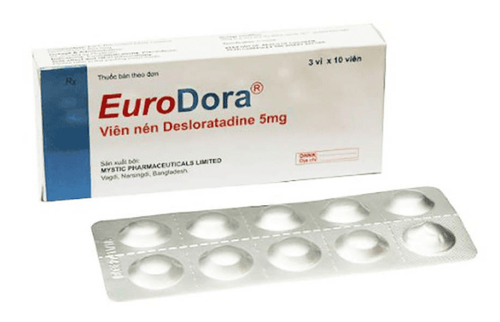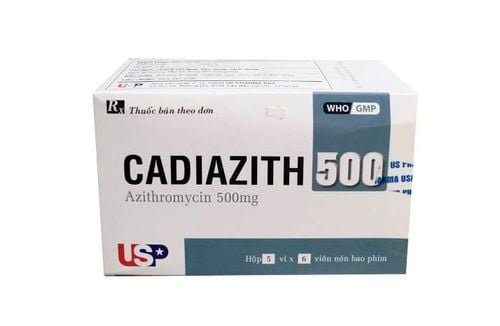This is an automatically translated article.
The same product of DHG Pharma, Zaromax has two dosage forms, powdered package for oral preparation and tablet form. So what are Zaromax 200 and 500 drugs? How to use it? Please read the article below.
1. What are the uses of Zaromax 200 and 500?
1.1. What are Zaromax 200 and 500 drugs? Zaromax 200 has the main ingredient Azithromycin (in the form of azithromycin dihydrate) 200mg and excipients just enough 1 pack (Kyron T112B, orange flavor powder, aerosil, sorbitol P60W). The drug is prepared as a powder for oral suspension. Packed in a box of 24 packs, each of 1.5 g. Zaromax 500 has the main ingredient Azithromycin equivalent to 500mg Aazithromycin and excipients (Dicalcium phosphate - HPMC K4M- modified starch- croscarmellose sodium- magnesium stearate- sodium lauryl sulfate- HPMC 606- HPMC 615- PEG 6000- titanium dioxide-talc). Zaromax 500 is made in the form of film-coated tablets, packed in a box of 3 blisters, each blister contains 10 pills.
Zaromax 200 and Zaromax 500 drugs are used to treat infections or respiratory tract bacteria very effectively such as: Bronchitis, pneumonia, sinusitis, tonsillitis ... The drug is recommended and used by doctors and pharmacists for both adults and children.
1.2. What are the effects of Zaromax 200 and 500? Uses of the drug Zaromax 200:
Zaromax 200 is indicated for use in cases of infections caused by bacteria sensitive to the drug such as: Lower respiratory tract infections including bronchitis or pneumonia and other infections bacterial skin - soft tissue, otitis media; upper respiratory tract infections such as sinusitis, pharyngitis or tonsillitis. It is also used to treat uncomplicated genital tract infections caused by Chlamydia trachomatis or non-multiresistant Neisseria gonorrhoeae. Uses of Zaromax 500:
Zaromax 500 is indicated for the treatment of infections caused by sensitive bacteria; lower respiratory tract infections such as bronchitis or pneumonia; bacterial infection in the mouth; Skin and soft tissue infections; acute otitis media or in upper respiratory tract infections. Zaromax 500 is generally effective against streptococci in pharyngitis, although data supporting the efficacy of Zaromax 500 and subsequent prevention of rheumatic fever are not currently available. In sexually transmitted diseases in men and women, Zaromax is indicated for the treatment of uncomplicated genital infections caused by Chlamydia trachomatis. Zaromax 500 is also indicated for the treatment of chancroid caused by Haemophilus ducreyi, uncomplicated genital infections caused by non-multiresistant Neisseria gonorrhoeae. Zaromax 500 can be used alone or with Rifabutin for the prevention of Mycobacterium avium-intracellulare complex (MAC), a common opportunistic infection in patients with advanced HIV immunodeficiency virus. . Indications for the use of Zaromax 500 in combination with Ethambutol for the treatment of disseminated MAC infection (DMAC).
2. How to use Zaromax 200 and 500
2.1. How to take Zaromax 200 and 500 Zaromax 200 is available as a powder and suspension for oral use and Zaromax 500 tablets are also taken orally. Patients take the drug 1 hour before meals or 2 hours after meals.
2.2. Dosage of drugs Zaromax 200 and 500 Dosage of drugs Zaromax 200:
Adults: For upper and lower respiratory tract infections, skin or soft tissue infections: Take a single dose of 500mg in the first day; 4 days after each day take 250mg. Sexually transmitted diseases: Use a single dose of 1g. In children: 10mg/kg body weight per day on the first day. From day 2 to day 5 use 5mg/kg body weight per day or as directed by doctor. Dosage of Zaromax 500:
The dose of Zaromax 500 is adjusted to suit each condition of the disease. Patients can take the dose as prescribed by a specialist doctor or the reference dose below:
Adults: Respiratory tract infections and skin - soft tissue infections: First day take 1 tablet/time, 4 Next day take 1⁄2 tablets/time per day. Sexually transmitted diseases: Take 1 dose of 2 tablets. Children: First day: 10mg/kg daily. 4 days later: Use 5mg/kg per day. Special subjects: Patients with liver failure : Do not use. Patients with renal impairment: The dose should be adjusted according to each patient's condition when the creatinine clearance is more than 40ml per minute. Handling missed dose:
If the patient misses a dose of Zaromax 200 or Zaromax 500, take it as soon as possible when you remember. However, if it is too close to your next dose, skip the missed dose and take your next dose at the scheduled time. Note that patients should not take Zaromax 200 or Zaromax 500 twice the prescribed dose. Treatment of overdose:
Currently, there are no specific reports of overdose symptoms of Zaromax 200 and Zaromax 500. Patients may experience nausea, diarrhea, hearing loss like when an antibiotic overdose. Macrolide group. The patient must adhere to the correct dose as prescribed. But if you have accidentally overdosed and have unusual symptoms, you should immediately notify a specialist for timely treatment.
3. Contraindications of Zaromax 200 and 500
Not recommended for patients with hypersensitivity to Zaromax 200 and 500, the component Azithromycin or any antibiotic in the macrolide group.
4. Drug interactions
Do not use together Zaromax 200 and 500 drugs containing azithromycin with ergot derivatives because of the possibility of poisoning. When co-administered with Cyclosporin, it is necessary to monitor the concentration and adjust the dose of Cyclosporin accordingly. When used concurrently with Digoxin, it is necessary to monitor the concentration of Digoxin because there is a possibility of increasing the concentration of Digoxin.
5. Notes when using Zaromax 200 and 500
Be careful when using the drug in the following cases:
Caution should be exercised when using Azithromycin and other Macrolides because the possibility of allergic reactions such as angioedema and anaphylaxis is very dangerous (although rare). As with other antibiotics, during use, signs of superinfection should be observed due to bacteria not sensitive to the drug, including fungi. Appropriate dose adjustment is required for patients with renal impairment with creatinine clearance greater than 40 ml per minute. Hypersensitivity:
As with erythromycin and other macrolides, rare serious allergic reactions, including angioedema and anaphylaxis (rarely fatal), acute generalized pustular rash have been reported. (AGEP), Stevens-Johnson syndrome (SJS), toxic epidermal necrolysis (TEN) (rarely fatal), and eosinophilic drug reactions. Some of these reactions to Azithromycin have caused recurrent symptoms and require longer monitoring and treatment. If an allergic reaction occurs, the drug should be discontinued immediately and appropriate therapy instituted. Physicians should be aware that allergic reactions may reappear once symptomatic treatment has been discontinued. Hepatotoxicity:
Since the liver is the major route of elimination for azithromycin, azithromycin should be used with caution in patients with severe liver disease. Abnormal liver function, hepatitis, obstructive jaundice, hepatic necrosis and liver failure have been reported, some of which have resulted in death. When signs and symptoms of hepatitis are observed, azithromycin should be discontinued immediately. Hypertrophic pyloric stenosis in infants:
During the monitoring of the use of azithromycin in neonates (using the drug up to 42 days of age), a case of hypertrophic pyloric stenosis in young children has been reported. Parents and caregivers should be instructed to immediately notify the doctor if a child vomits or becomes irritable during feedings. Drugs of ergot origin:
In patients taking drugs of ergot origin, the risk of ergot toxicity is increased when used in combination with macrolide antibiotics. There are no data on the potential for an interaction between ergot and azithromycin. However, because ergot toxicity is theoretically possible, the co-administration of ergot-derived drugs with azithromycin is not recommended. Superinfection:
As with any antibiotic preparation, signs of superinfection by non-susceptible organisms, including fungi, should be observed. Clostridium difficile-associated diarrhea:
Clostridium difficile-associated diarrhea (CDAD) has been reported with the use of most antibacterial agents, including azithromycin, and the severity can range from mild to moderate diarrhea. fatal colitis. Treatment with antibacterial agents alters the natural microbial population of the gut leading to overgrowth of c. difficile. C. difficile produces toxins A and B that contribute to the development of CDAD. Supertoxin-producing strains of c. difficile increases morbidity and mortality, as these infections may be resistant to antibiotics and may require a colectomy. CDAD should be considered in all patients presenting with diarrhea following antibiotic administration, and history should be taken carefully because CDAD has been reported more than 2 months after administration of antibiotics. Renal impairment:
In patients with severe renal impairment (GFR < 10 ml/min), a 33% increase in systemic exposure to azithromycin was observed (see Pharmacokinetics). Prolongation of the QT interval:
Prolongation of myocardial repolarization and QT interval, increasing the risk of arrhythmias and torsades de pointes, with macrolides, including azithromycin (see Adverse Reactions). ). Prescribers should consider the risk of potentially fatal QT prolongation when weighing the risks and benefits of azithromycin for at-risk groups. Myasthenia gravis:
There have been reports of exacerbations of myasthenic symptoms in patients treated with azithromycin. Use in pregnant women and nursing mothers:
Currently there is little information on the effects of the drug on fetal development as well as the ability of the drug to be excreted into breast milk. Use in pregnancy and lactation only if the potential benefit to the mother has been carefully assessed to outweigh the potential harm. People who drive and operate machinery:
Drugs that cause dizziness, headaches should be used with caution when using with drivers or when operating machinery.
5. Side effects of Zaromax 200 and 500
The most common are gastrointestinal disturbances (about 10%) but are usually milder and less frequent than with erythromycin. A transient change in the neutrophil count, or a transient increase in liver enzymes, may also occur, sometimes with rash or headache and dizziness.
Effects on hearing: Long-term use of high doses, Zaromax 200 and 500 containing azithromycin may cause reversible hearing loss in some patients. Common: Vomiting, or nausea, vomiting, abdominal pain and diarrhea. Uncommon: Fatigue, headache and dizziness, somnolence or rash, itching. vaginitis and cervicitis,... Rare: Anaphylactoid reactions. Angioedema. Elevated transaminases. Transient neutropenia. Inform your doctor about any unwanted effects you may experience while using the drug.
6. How to store Zaromax 200 and 500
Store Zaromax 200 and 500 in a cool, dry place, at a temperature not exceeding 30°C, in the original packaging and protected from light. Keep out of reach of children and pets. The concentration, content, and active ingredients of the drug may be affected if Zaromax 200 and 500 are not well stored, or when the expiry date is over, leading to harm to the patient when used. Please read carefully the storage information and the expiry date of the medicine listed on the product packaging and the instructions for use of the drug Zaromax 200 and 500 before use. When the medicine is past its expiration date or the patient is no longer using it, consult your doctor, pharmacist or waste disposal unit for a safe way to dispose of the medicine. Medicines should not be thrown down the toilet or plumbing unless asked to do so. Above is all information about Zaromax 200 and 500 drugs, patients need to carefully read the instructions for use, consult a doctor / pharmacist before using. Absolutely do not arbitrarily buy Zaromax 200 and 500 drugs to treat at home because there may be unwanted side effects.
Please dial HOTLINE for more information or register for an appointment HERE. Download MyVinmec app to make appointments faster and to manage your bookings easily.













